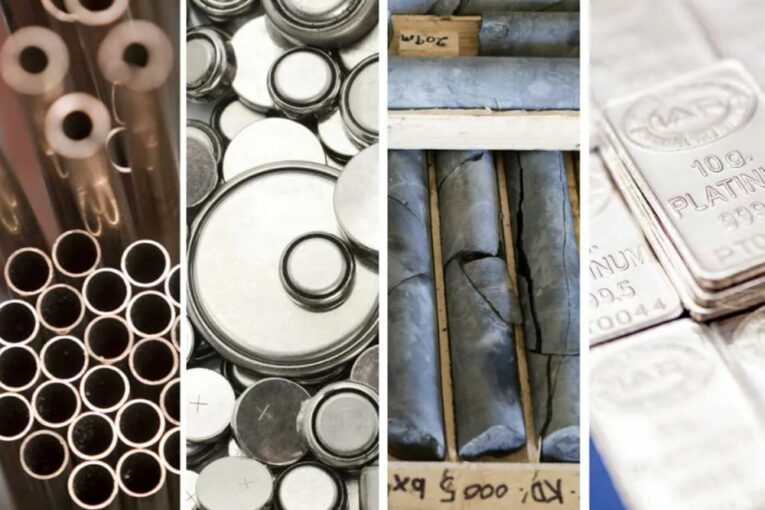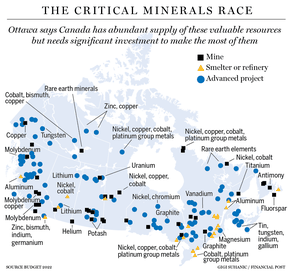
Few issues are as hotly debated as the costs of climate change, and the new federal budget is unlikely to cool the tenor of that discussion.
Chrystia Freeland’s second budget as finance minister proposes billions of dollars in new spending to incentivize more mining of critical minerals through investments in infrastructure, tax credits for exploration, and funding to help attract the downstream industries that turn those minerals into products such as electric vehicles and battery cells.
Critical minerals include not only the lithium, nickel and cobalt used in batteries, but a far wider array of elements, from copper to manganese. The budget proposes allocating at least $3.8 billion in cash, plus more in tax credits, between now and 2030, to develop a supply chain of critical minerals. Whether that investment sounds like too much money, or far too little, depends on how you view the threats posed by climate change and the urgency of the energy transition.
In any case, here’s how some of that spending breaks down:
Mining Infrastructure
Much of the strategy outlined in the budget hinges on the idea that creating a supply chain will help attract industrial investment to Canada, and thus boost future economic growth. To that end, Prime Minister Justin Trudeau’s government would spend up to $1.5 billion by 2030 on the infrastructure needed to get those materials from the ground to factories.
Think about projects such as Ontario’s Ring of Fire in the James Bay Lowlands, the site of deposits of nickel, copper, and other metals, but isolated from the rest of the province because road access is limited.
Wyloo Metals Pty. Ltd., a closely held Australian company that spent more than $600 million to acquire the minerals claims in the Ring of Fire, has said the government needs to build a road so that it can transport bulk metals out of the region. Easier said than done. A road would cost hundreds of millions of dollars, at minimum, and would have immense impacts on the handful of First Nations’ communities that live in the region, not all of which are keen to see the project move forward.
“Critical mineral mining projects are expensive and come with a unique set of challenges that can often include remote locations, changing prices, and lengthy regulatory processes,” the budget said. “Making these projects a less risky undertaking for companies will help grow both Canada’s critical mineral industry and secure the good resource jobs of the future.”
Pierre Gratton, president of the Mining Association of Canada, the industry lobby group, noted that the World Bank has estimated that billions of tonnes of minerals and metals will be needed to build the wind turbines, solar panels and renewable energy projects to reach global climate change goals.
He said low commodity prices stifled mineral exploration in Canada, and much of the rest world, but amid global supply chain bottlenecks and a burgeoning electric vehicle sales industry, that’s all changing.
“This exceeded expectations,” Gratton said, about the budget funding for a critical minerals supply chain. “This is going to put a lock on Canada’s position as top spot for, for exploration, I believe.”

Exploration
In keeping with its past preference for tax credits, and as Trudeau’s Liberals advertised in their election platform, the budget includes a non-cash, new “Critical Mineral Exploration Tax Credit.”
The measure would allow mining companies to claim up to 30 per cent of specified exploration expenses related to critical minerals as a tax credit; or to be claimed as a flow-through share agreement, in which such tax credits are passed on to investors. That would last until March 2027.
By itself, that credit could amount to billions of dollars. The budget notes that between 2017 and 2021, mineral companies listed on the Toronto Stock Exchange and its Venture Exchange raised nearly $45 billion for mineral exploration and mining.
“The tax credit would apply to certain exploration expenditures targeted at nickel, lithium, cobalt, graphite, copper, rare earths elements, vanadium, tellurium, gallium, scandium, titanium, magnesium, zinc, platinum group metals, or uranium,” the budget states.
The budget adds that the tax credit would help enhance Canada’s capital markets, perhaps setting up Toronto to take a leading role in global mining finance.
Indigenous communities
Some of the most geologically prospective critical mineral belts are located in regions inhabited by indigenous communities. The budget proposes $103.4 million over five years so Natural Resources Canada can develop “a National Benefits-Sharing Framework,” which would include an expansion of the Indigenous Partnership Office and the Indigenous Natural Resource Partnerships program.
Essentially, this is supposed to help ensure that mining projects benefit indigenous communities. It’s common for indigenous communities to say that they lack the resources to independently evaluate the scale and impacts of mining projects, and the budget proposes that at least $25 million of the $103.4 million be used to fund “early engagement” with Indigenous communities.
Attracting clean Industry
In recent months, the federal government has made clear that it believes a green electricity grid will attract industrial investment in Canada from companies looking to cut their emissions.
The budget adds $1 billion over six years to its Strategic Innovation Fund, meant to help industry decarbonize.
In the past year, the Ministry of Innovation, Science and Economic Development has relied on the fund many times to help incentivize investment from industry in ‘clean economy’ projects. Last week, for example, Trudeau announced $259 million in support for General Motors Co. — matched by the province of Ontario — to build electric vehicles in Ingersoll, and to add a new shift in Oshawa. In the past, the fund has supported other plants in the electric-vehicle supply chain, as well as other industries such as steel plants looking to reduce emissions.
“Combined with $500 million drawn from existing program funding, this will provide $1.5 billion in targeted support towards critical minerals projects, with prioritization given to manufacturing, processing, and recycling applications,” the budget said.
The budget also suggests that the government may use the fund to begin supporting solar panel project development.
There’s also $144.4 million over five years for Natural Resources Canada and the National Research Council “to support research, development, and the deployment of technologies and materials” to support critical mineral value chains.
Trent Mell, chief executive of Toronto-headquartered Electra Battery Materials Corp., which is developing a cobalt refinery near Cobalt, Ontario, and plans to refine nickel in the future, said the budget creates a focus on the missing parts of in the battery supply chain.
“I think it’s going to be a boon to the what I call the midstream of the auto supply chain,” said Mell.
He said in recent, government loans and grants have attracted electric vehicle assembly plants and battery cell manufacturing. But there’s still a lack of industrial operations for a series of steps required to convert ore, such as cobalt, nickel and lithium, into the various chemical forms necessary to make batteries.
Transportation infrastructure
Some of the spending promises would merely maintain transportation infrastructure, which has been damaged by extreme weather events that some scientists attribute to climate change.
Flooding and wildfires in western Canada have impeded the flow of commodities such as lumber and steelmaking coal out of British Columbia, contributing to inflation. Making Canada’s infrastructure resilient against climate change will require tens of billions of dollars of investment at minimum, according to some estimates.
It is taken for granted that well-functioning supply chains are necessary for the overall economy, and the budget envisions massive spending to keep roads open and goods moving.
For instance, Transport Canada would receive $603.2 million over the next five years, including $450 million to help ease the movement of goods across Canada’s transportation networks.
That pledge would come on top of $4.2 billion that has been allocated to the National Trade Corridors Fund since 2017, which will be renamed to reflect a new focus on supply chains.
An additional $136.3 million will go to developing industry-driven solutions to use data to make our supply chains more efficient.
• Email: [email protected] | Twitter: GabeFriedz
You can read more of the news on source
